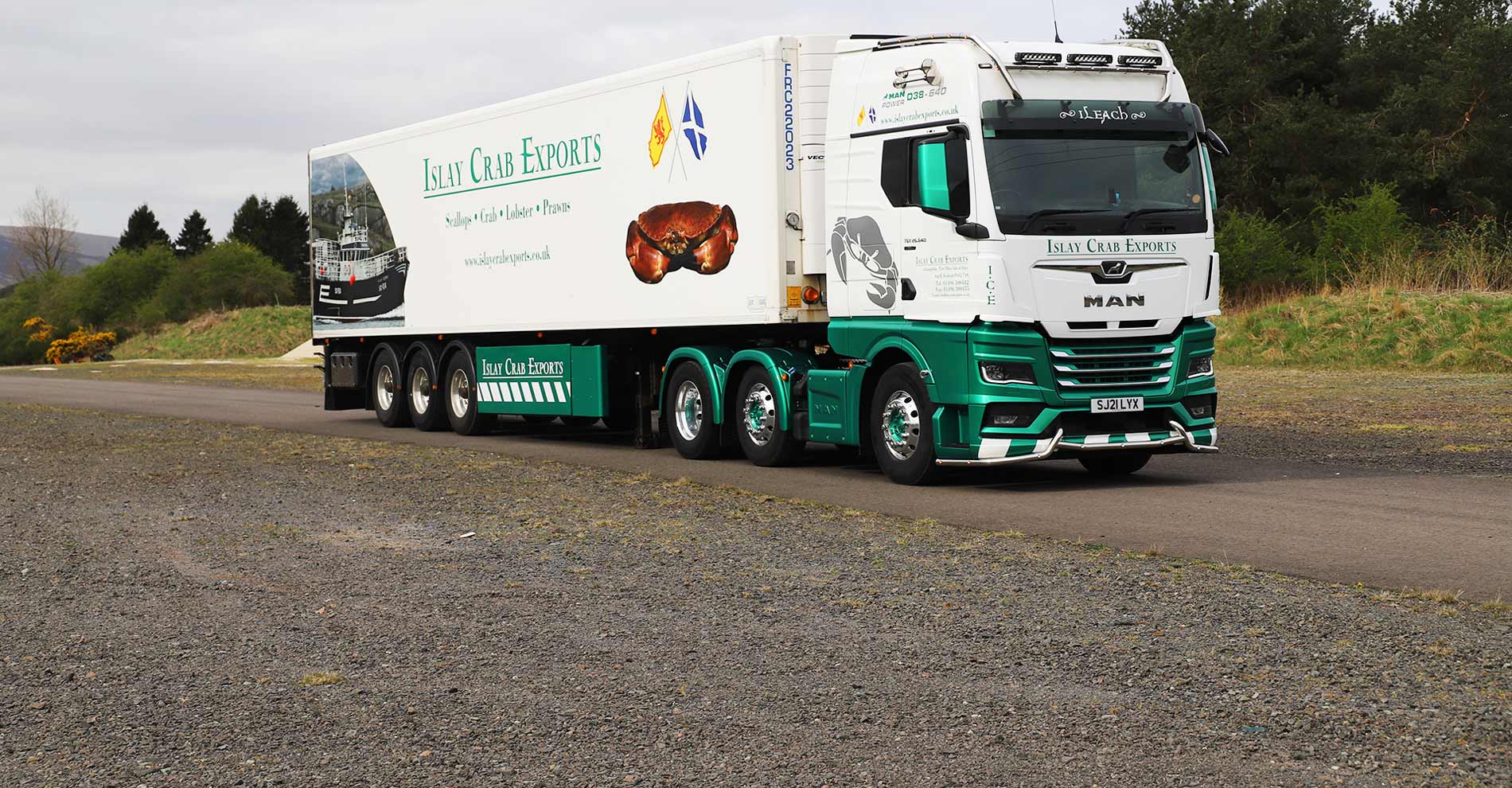
The ICE MAN cometh!
Transporting shellfish and crabs from the West Coast of Scotland requires a powerful truck and a dedicated driver. Islay Crab Exports has both: with its MAN TGX 26.640 and the experienced trucker Hector Murray at the wheel.
Specialist transport of valuable live cargoes is never easy and requires the right attitude from the driver, as well as the right equipment. That likely played a role in the recent decision by Islay Crab Exports (ICE) to put an incredibly smart MAN TGX 26.640 on the road, driven by 53-year-old Hector Murray.
As the name suggests, the company’s main business is the processing and sale of crabs and mussels, which are caught by local fishermen or the five scalloper boats owned by the company and landed in the waters near their location. They are then sold to all manner of customers throughout Europe. Spain is the largest market, but ICE does not take the goods there; instead it loads them onto a Spanish truck in Reading. That’s still about 700 miles and two days there and back. The company was founded in 1985 by James Monaghan, who was 19 years old at the time. It processes scallops in its own factory on the Isle of Islay.

Alive and snipping
When it comes to ICE cargoes, there is another factor that makes transport a little different to the norm: the mussels and crabs are alive. And that means that they must be stored in the right conditions, or else they will die and be useless to the customer. That in turn means that the trucks need to be equipped for this unusual task.
The live shellfish are transferred to storage containers until they are ready for delivery. Generally, the truck is loaded in Harris and then drives to Larkhall, near Glasgow, to load more goods from Ireland and Islay. Hector usually stops there overnight and then continues south to Chieveley Services, near Reading, where he meets a Spanish truck that takes on the load. The live cargo has to be moved from one truck to the other by hand, which takes quite a bit of time and effort.
When fully loaded, the truck has a gross weight of 40 metric tons; that weight must not be exceeded, because it is the maximum permissible gross vehicle weight for trucks in France and Spain. A typical load consists of 10–12 metric tons of crabs, with the rest of the weight made up of the equipment and salt water in which the animals live. The journey from Harris to Reading and back takes a week, but if the weather at sea is bad, the fishermen cannot go out – so there is no catch, and therefore no cargo. For some time now, the company has always opted for MAN when buying trucks.
‘We’ve been driving MAN since 1981 and we never shop around for other makes.’
Despite the terrain and heavy loads, the MAN trucks achieve good average fuel consumption – that also applies to the large MAN TGX 26.640, even though it has to cover 50% of the distance in the Highlands and on the islands. ‘The trucks are very reliable,’ says Hector. ‘I only seem to be in the garage for inspections and routine maintenance. Or to put it another way: it always gets me home!’
Maximum specifications
Since it was to be his office and home every week, Hector had free rein in terms of the specifications of the truck. Of course, he chose the biggest and best! And also the largest GX cab, which is very spacious inside and, equipped with two bunk beds, is perfect for a week on the road. Hector’s lion also looks great, with stunning green and white metallic paintwork, including mirrors with graphics. It also has some subtle adjustments: a lower light bar under the bumper and an upper light bar that is more functional than for show. The light bars cast extra light on the narrow single-lane roads in the Western Highlands at night, which helps Hector a lot. ‘I really like the new MAN TGX, especially the new steering wheel, which gives you a good view of the dashboard,’ he says.
A lot of attention is paid to securing the load. It is very valuable and must be transported under exactly the right conditions, otherwise the animals will die and the cargo – and thus the profit – will be lost. Inside the trailer is a series of large open tanks on both sides, filled with the right type and level of water. However, the salt water needs to be oxygenated, and this is done through a hose connected to a frame that delivers the oxygen to the water. To supply the oxygen, the trailer has two special engines mounted on the underside – one of which is essentially a spare, so that if the first one fails, the load can survive and be saved by firing up the other engine. The system automatically notifies Hector if there is a fault in the power supply, allowing him to act quickly. No corners have been cut anywhere. Each prawn is individually tubed so that they cannot attack each other. The crabs have their claws nicked so they don’t bite each other, and the lobsters have elastic bands on their claws to stop them nipping. If you do not prepare the cargo properly, you may have a crustacean war on your hands!
Scottish mussels and crabs are considered delicacies appreciated all over the world, especially in Europe. Hector and his impressive MAN play an important role in this niche sector of road transport, ensuring that everything reaches the customer or the table in perfect condition.
Photo and text: pip.dunn@eastfieldmedia.com





